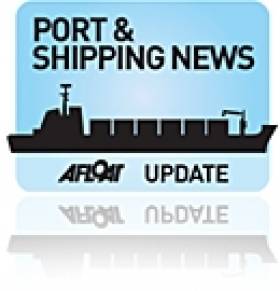Displaying items by tag: Searose FPSO
Small Vessel Plays Role Between Harland & Wolff Facilities to Support Upgrade of Giant FPSO Ship
A small vessel has been used by the Harland & Wolff Group as part of a contract at their Belfast shipyard to provide a mid-life upgrade of a 150,000dwt Floating Production and Storage Offloading (FPSO) vessel, writes Jehan Ashmore.
The giant Canadian flagged MV SeaRose FPSO which operates in subwell oil fields off Newfoundland and Labrador, Afloat reported of its recent arrival to Belfast. On the other side of the North Channel, the Group’s Arnish yard on the Isle of Lewis & Harris in the Outer Hebrides off Scotland, is where specialist parts were manufactured as part of the refit upgrade of the 271m long FPSO vessel .
On completion of manufacturing the test pieces, they were loaded on board the 33m MV Carly, a workboat, support and landing craft which Afloat has identified is operated by Ferguson Transport & Shipping based in Annat, Corpach, Fort William in west Scotland.
The project cargo was delivered to a very tight deadline, with the team at H&W Arnish, working 24 hours a day to complete buoy seal test plates to schedule. Such an operation demonstrates H&W’s multi-site business model which allowed the shipyard Group to drive capacity and capability to serve client requirements where it is needed.
Currently the yard at Arnish employs a 150-strong workforce and has an apprenticeship programme in place. At the 38 hectare development site located at Arnish Point, is a 21,000m² area with purpose built fabrication and assembly halls and administration offices.
With its deep water quay, Arnish offers unrestricted access to the Atlantic and North Channel, that enables the facility for the shipment of materials and completed fabricated components.
Harland & Wolff Secure Dry-Docking Contract of Canadian FPSO
#PORTS & SHIPPING – Harland & Wolff Heavy Industries Ltd (H&W) have secured a contract to dry dock and service the Searose (2004/139,950dwt) a Canadian east coast based floating production storage and offloading (FPSO) vessel later this year.
The 272 metres long by 46 metre beamed FPSO is operated by Husky Oil and is based at the White Rose oilfield, 350km off the Newfoundland coast.
Searose will be dry-docked at H&W's Belfast Repair Dock and also use the Repair Quay during May and June. The work at the Queen's Island facility will be led by an integrated project team made up of owner and H&W personnel along with key contractors and vendors.
"H&W, along with our key contractors, are pleased to have secured the SeaRose FPSO project and to demonstrate the capabilities of the UK Oil & Gas supply chain," said H&W Project Manager James Lappin.
"This is an important opportunity, not only for H&W but for Northern Ireland, to extend a welcome to our Canadian visitors and demonstrate our world class facilities."
"We are proud that they have put their trust in us," H&W Chief Executive Officer Robert J Cooper said. "All levels of H&W are committed to ensuring this important project is completed safely and successfully."
H&W was founded over 150 years ago and has built some of the world's most famous ships, including three from the White Star Line: the Olympic, Titanic, and the Britannic, P&O's Canberra and the RN World War II battle-cruiser HMS Belfast, where she remains at moorings on the Thames.
























































